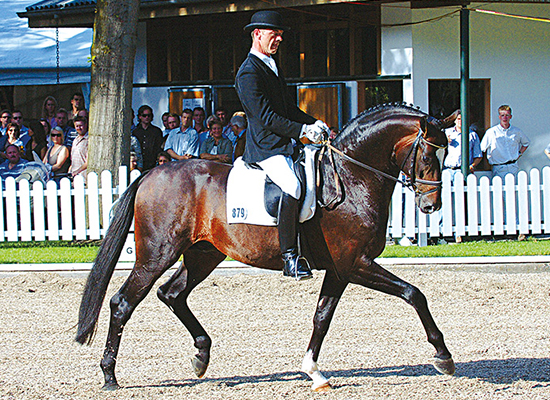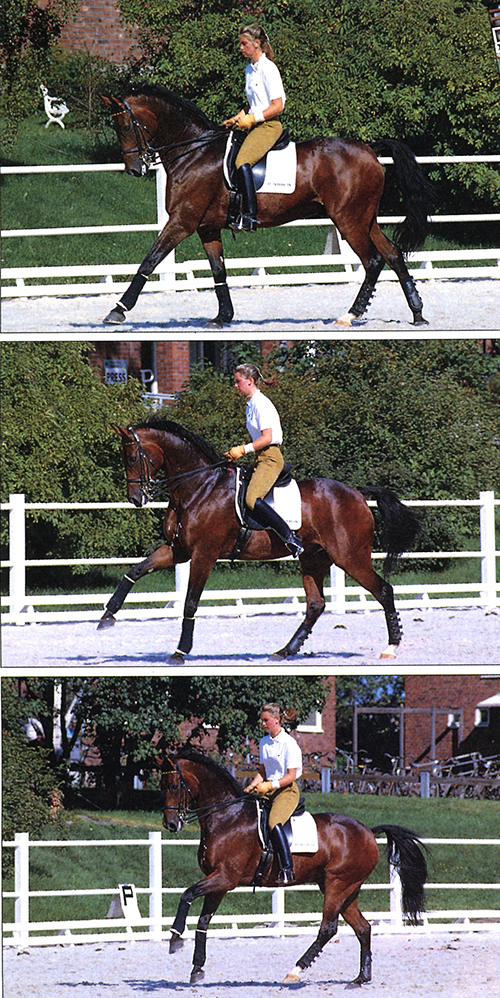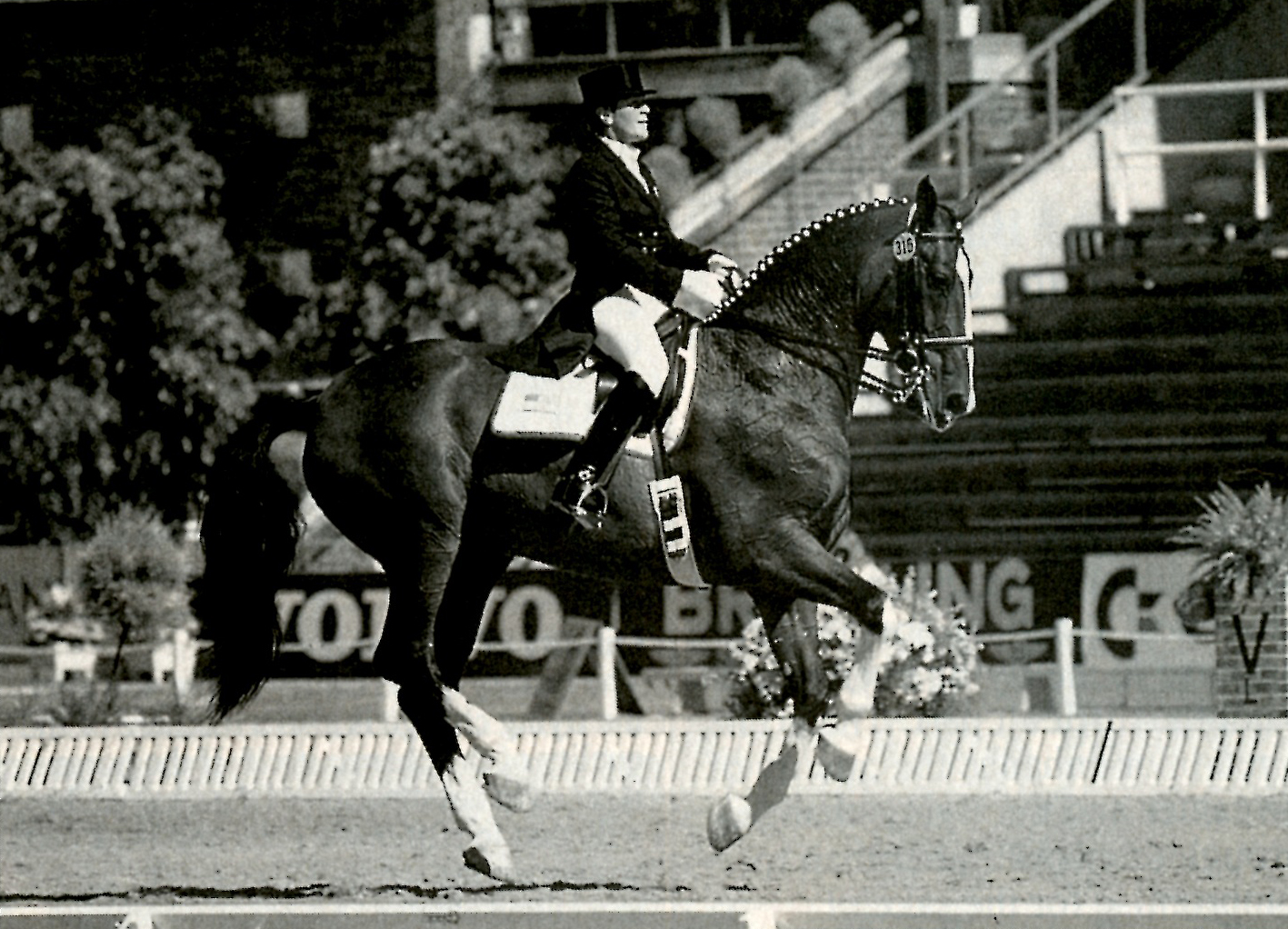Pics are Nicole Uphoff and Rembrandt in a training session with Harry Boldt at the WEG in 1990 – they went on to win the Grand Prix. Rest of the pix are from THM archives.
Christopher Bartle turns his attention to the canter
Flying changes represent for most riders the most dramatic or most difficult part of the dressage horse’s training, other than the piaffe passage and the canter pirouettes. Teaching horses the response to the flying change aids is not the difficult part. The art is to retain or enhance the quality of the canter and the flying changes through the work, rather than to compromise for the sake of obtaining the change of leg. The secret as ever lies in concentrating on the basic principles as explained in the whole of this series of articles.
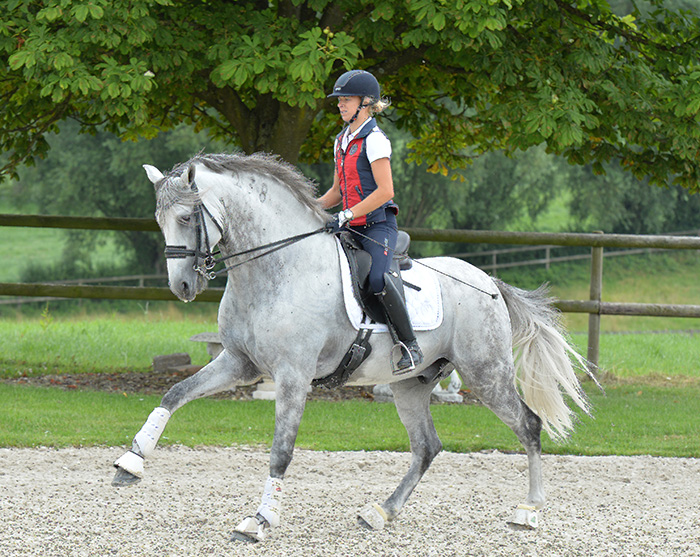
Quality of the change
The quality of the flying changes is reflected in the expression, the length of the change, the straightness and the quality of the canter before and after the change. When we talk of changes having expression, we mean that during the stride of the canter in which the change is executed, the canter has a definite moment of suspension. This enables the horse to bring the new inside hind well under the body and to reach out with the foreleg. Expression should not be confused with tension. A horse which is relaxed in its work and yet carrying itself with the passive tension that a horse in collection must have, will cover the same amount of ground in the change as in the normal collected canter.
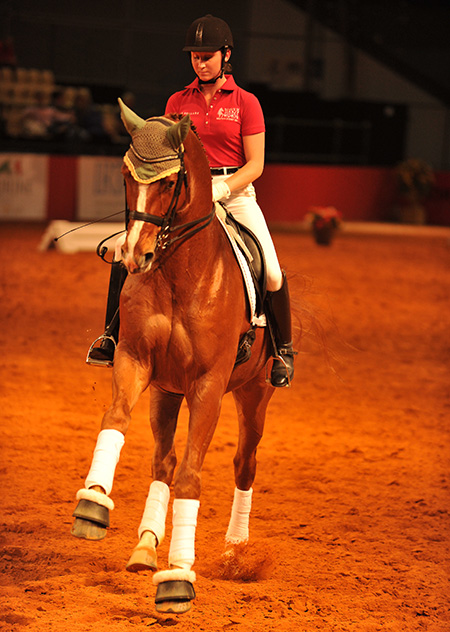
The straightness of the changes is as important in the change as in the preceding canter. In the earlier articles in the first series, the straightness of the canter was stressed as one of the main priorities. The horse has a natural crookedness which causes most horses to have the quarters to the right and the shoulders to the left This means that in canter right, the horse tends to curl around the rider’s right leg too much and to cut in with the quarters through the turns and circles. On the left rein he comes against the rider’s inside leg and is reluctant to offer the lateral flexion to the left If the canter preceding the changes is not straight, the flying changes will not be straight. In addition, the length and expression of the change will be adversely affected because if the new inside hind is stepping slightly to the side as it comes through, then it will be less able to step well under the horse’s body.
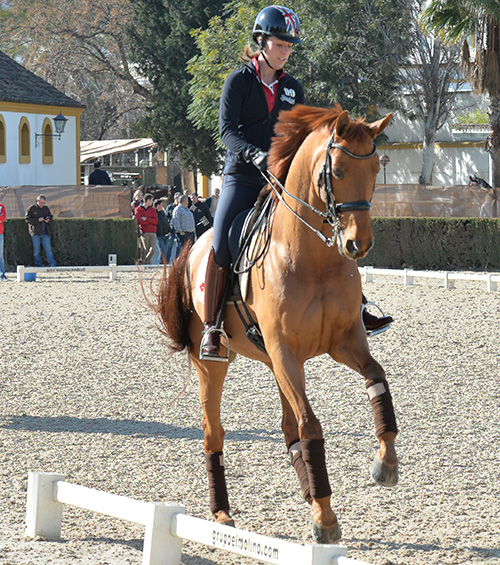
Quality of the Canter
The quality of the canter before and after the flying change is also a measure of the quality of the change itself. If the horse is tense in anticipation of the change, he will tend to stiffen the neck and back and so shorten the stride. This tends to lead to a stilted change. An equally common fault in the flying change, especially at the beginning of this phase of the work, is the tendency to take hold of the bit and take charge after the change. Of these two faults, the first is the more serious and should be corrected as soon as the tension is felt rather than proceed with the changes.
Before starting the work of teaching the flying changes, the quality of the canter should be well established. The horse should be thinking forward, should accept the slowing and collecting aids and should be laterally submissive. The horse should be straight in the canter.
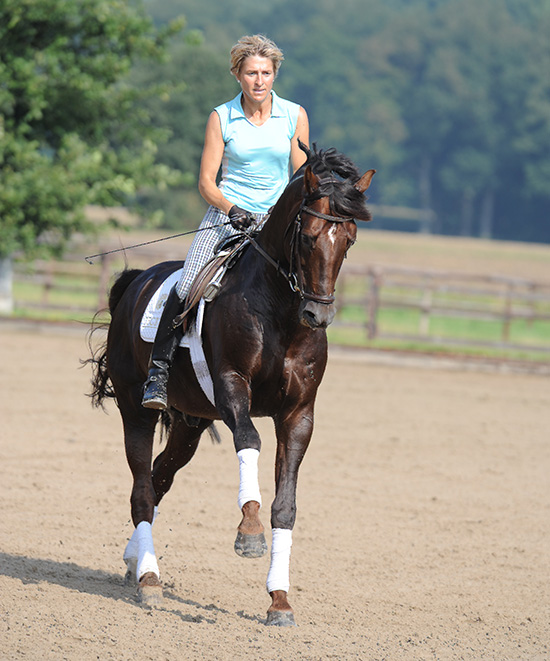
Once the horse has learnt changes it is more difficult to straighten him as he will find it easier to change rather than straighten. The counter canter must be well established. The horse must be able to perform the counter canter without losing the elasticity of the back and without becoming crooked. The work on collection must have commenced through the smaller circles, the pirouette type turns and the response to the collecting actions of the rider. As the canter is collected, the moment of suspension should not be lost as this is the moment at which the change is executed. A shorter moment of suspension will mean that the flying change will lose expression.
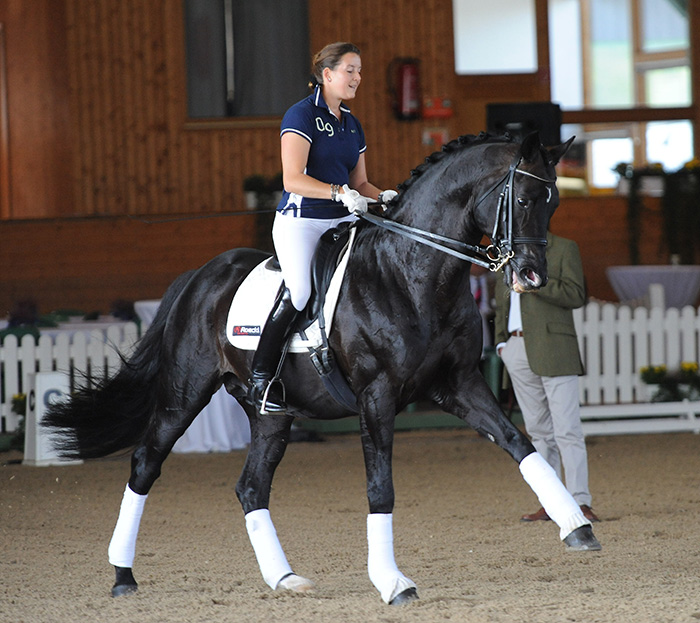
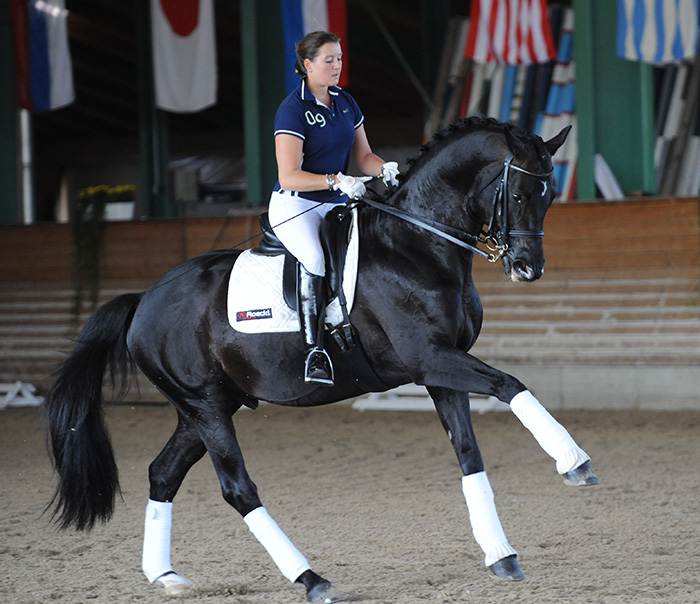
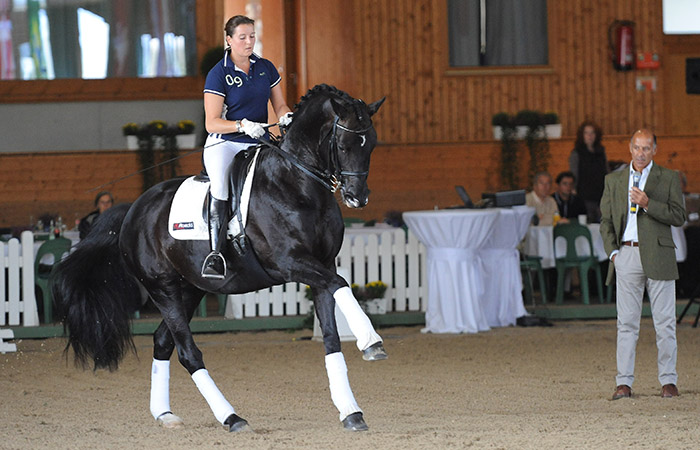
Preparation
The simple change through walk is not only a good exercise to collect the canter, but is also a good preparation for the changes. The horse should be able to come directly back to walk from canter and then proceed from walk to canter without any trotting steps. The transition to walk should be executed with the hind leg well engaged and the horse remaining ‘up and out’ in front. A common fault is the stiffening and straightening of the hind legs which causes the horse to become ‘croup high’ in the transition. The serpentine of five loops with simple changes on the centre line as performed is a very useful exercise.
The simple change, although a good preparation for the changes, is not the means by which the horse is trained to understand the aids for a flying change. The flying change involves a change of lead through the canter stride. Riders who use the simple change to teach the horse the aids for the flying change will have difficulty in obtaining free forward changes.
Teaching the Aids
If the quality of the canter is established, the rider will be able to maintain the rhythm, the balance, the straightness and the ‘jump’ in the canter without difficulty whether in true canter or counter canter. It is at this moment that the work on the flying changes can commence.
Obviously in teaching the horse the response to a new set of aids, there will be some loss of relaxation, some tension caused in anticipation, but if the rider concentrates on the basics and returns to these whenever necessary, the horse will learn to perform a single flying change without tension. Not all horses will have brilliant changes just because not all horses have it in them to show a really good canter, due to conformational and other difficulties, but this should not mean that the rider should not go on to teach the horse flying changes.
The preparations for the changes are as important as the aids themselves and the timing thereof. The preparations basically involve checking on the priorities in the canter and working for the lateral submission to the side to which the change is to be made. Once this is established the rider can apply the aids to ask the horse to change. The aids for the change should be just a change of the position of the seat in the saddle which affects the positioning of the hips and places the new inside hip in front of the outside one. The rider should try not to slip to the outside during the change.
The signal/stimulus for the change is given by a combination of new inside leg at or in front of the girth and new outside leg just behind the girth. In the earlier work, the role of the inside leg as the signal for the canter strike off was emphasised and so too in the changes it should mainly be the stimulus of the inside leg which asks for the change while the outside leg stays at or just behind the girth so that the horse does not jump to the side. The rider must above all make sure that, in applying the leg on one side, the other does not come away from the horse.
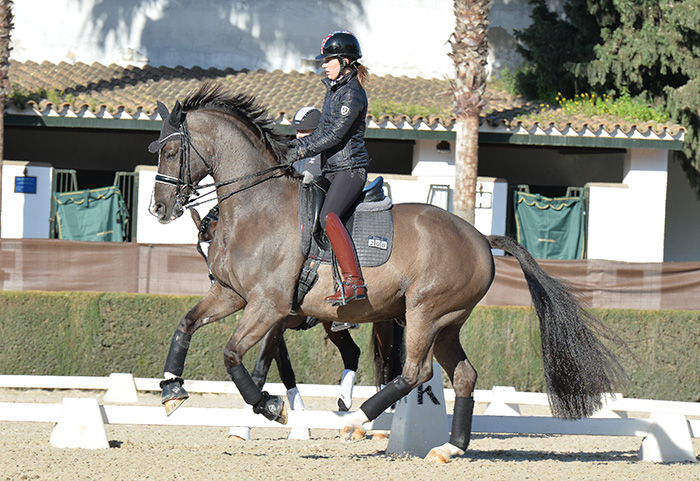
Unobtrusiveness
In all training, the rider should endeavour to teach the horse to respond to the most discreet of aids. The perfect result is a horse which appears to the spectator to respond to invisible aids. In the case of the flying changes this is all the more important. One frequently sees riders swinging the outside leg well behind the girth almost to the point of the stifle which then causes them to leave the saddle with the seat and to pivot on the knee. Once series changes start, this becomes all the more important The inside hip and inside leg should move in sympathy with the horse’s inside hind leg/hip.
Of course at the start of the work on the changes the stimulus needs to be sharp enough to cause a reaction. This will differ from horse to horse and with some horses will be a mere suggestion while with others it will be accompanied by a tap of the whip just behind the outside leg. It is unusual for the horse which is just learning changes to react to the first stimulus and so the rider must repeat the aid until the change occurs. The repetition of the aid should be every other stride rather than every stride and can be gradually applied more sharply with the support of the whip.
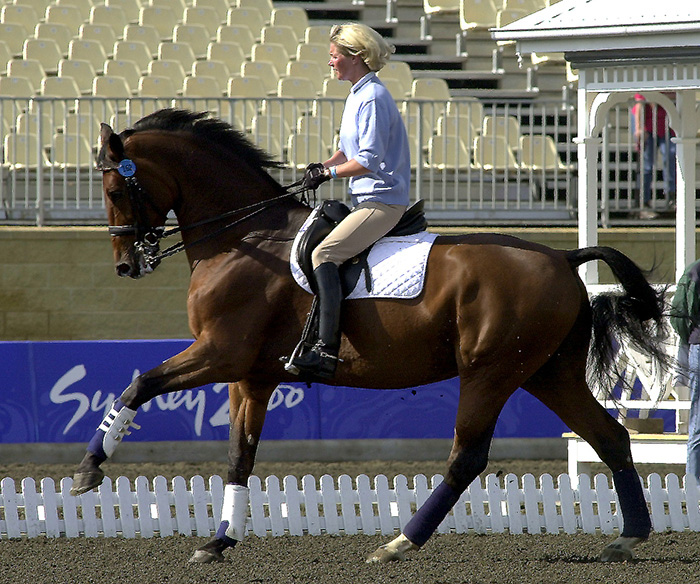
Timing
The timing of the aids is of course crucial. Once the horse is ready for the flying change and the rider has made the necessary alterations in his position in the saddle to ask for the change, then the stimulus from the leg and inside hip must come at the moment which allows time for the message to travel to the horse’s brain and back to the horse’s legs so that the change can be made while the horse’s legs are off the ground during the moment of suspension. As the horse’s training progresses, the time must be altered slightly because the flying change will be done as a reflex act in response to the rider’s aids and the message to the brain will be short circuited. Initially then, the stimulus should be given as the leading foreleg is about to come to the ground. Gradually the stimulus will be given a fraction later until it is given at the start of the moment of suspension.
During the stride of the canter in which the change is executed the canter has a definite moment of suspension
Exercises
As in much of the schooling work, the use of exercises helps to produce the result one wants. As mentioned in earlier articles, the rider should always be inventive. The exercises described below are useful at the very start of the process of teaching the horse the correct response to the flying change aids because they tend to predispose the horse to change. One exercise is no better than the other but different horses respond differently and find one exercise easier to understand than another.
Exercise 1: The horse is asked to turn down the centre line in canter and then to execute a half pass towards the track. Approximately two metres before the track the horse should be ridden forward straight while the lateral submission is obtained towards the new inside leg and then the rider starts to ask for the change repeating the aid every other stride and supported by the whip if necessary. The priority remains the straightness, the rhythm and the lateral submission even as the strength of the stimulus is increased.
Exercise 2: The horse is ridden in counter canter up the long side. The aid for the flying change is given between the first quarter marker and is repeated until just before the end of the long side or until the flying change is executed. If not successful, do not continue to ask around the short side but rather repeat down the next long side and perhaps support with a tap of the whip. Once again the priorities remain the same and the aids for the change must always be secondary to maintaining the basics. If the horse changes in front but not behind then the rider should continue to ask every other stride until the horse changes behind, rather than come back to walk and start again. The horse must learn to come through more quickly behind rather than come back to trot or walk.
Exercise 3: The horse is ridden in collected canter deep into the second corner on the short side and then ridden out of the comer on to a shallow loop approximately three metres away from the track. The rider then asks for the change at the moment of straightening to ride down the long side. This exercise is useful with horses which appear to show no inclination to ‘have a go’ at a flying change but the timing of the aid just at the moment that the horse is ridden straight and out of the shallow loop is crucial.
These exercises are but three of the many which are possible. The exercises must be used in relation to the horse’s temperament and schooling problems and should not be thought of as each being relevant to every horse. At the start of the work the horse will often respond by changing late behind, or, less commonly, late in front. Partly this is a result of the timing of the aid and the fact that at the start of the work the horse’s brain is involved in deciphering the message and partly as a result of a lack of collection which causes the horse to disengage rather than engage during the flying change.
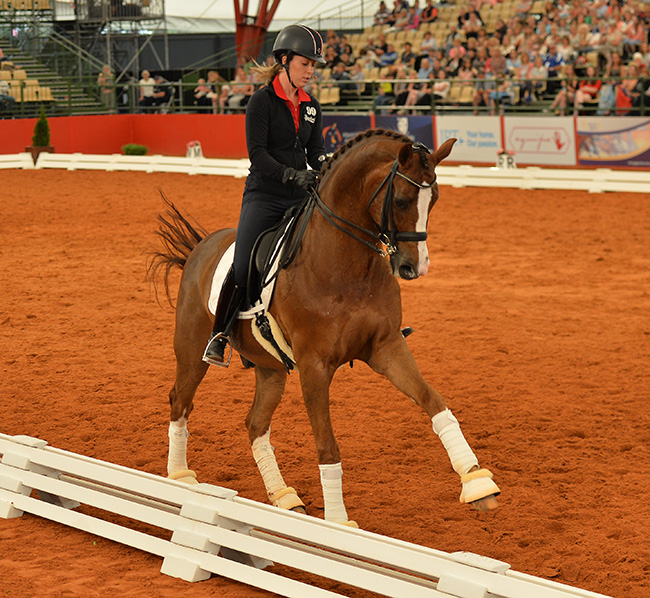
As the horse comes to recognize the preparations for the changes and even gets to the point of anticipation, it becomes easier for the rider to collect the canter during the preparation and to maintain the engagement through the change. In addition, the response becomes a reflex action and therefore the flying change will happen more immediately at the moment of the application of the stimulus.
Consolidating the Movement
Consolidating the single flying changes with most horses takes quite a few months and with some at least a year or more because they find it so exciting or difficult. In general the bigger the horse’s canter and the more volatile the horse in temperament, the longer it takes. The work mainly consists of working on the basics particularly as the horse anticipates the changes and in so doing stiffens the back, blocks the lateral submission, stops going forwards or conversely does not accept the slowing aids.
The more inventive the rider can be in terms of where the changes are executed, the less the horse will be inclined to anticipate. It should be possible eventually to perform single flying changes at will anywhere in the arena and from true canter to counter canter. It should be possible to perform the single flying changes on a circle as well as on a straight line.
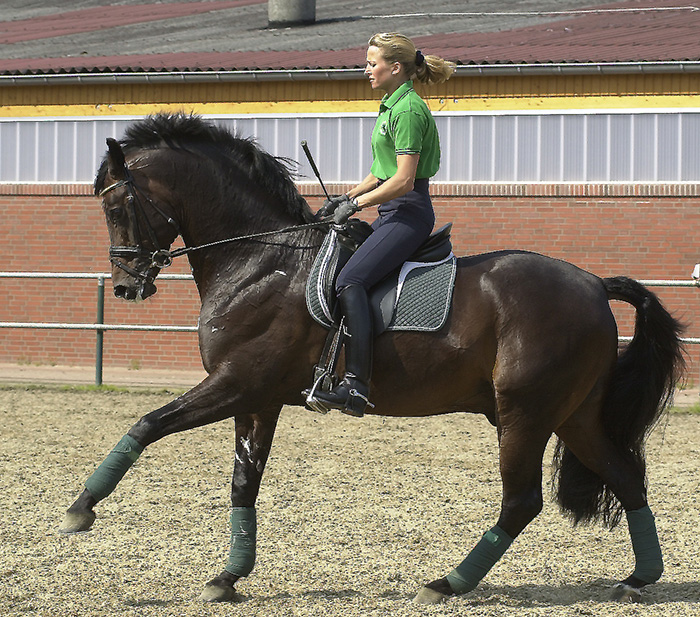
The quality of the canter before and particularly after the change will provide the indicator to the rider as to when the horse is ready to start series changes. In general the horse can be said to be ready to start four-time changes if after performing a flying change he is able to come back to a good, straight, balanced, collected canter within three strides. For three-time changes, then it should be two strides and for two time changes there is only one stride. So by then a horse should be remaining correct in the canter during and after each change.
The main point to remember in all the work on flying changes is to be prepared whenever necessary to go back to square one to re-establish the basics before building up to the changes again. The most common fault for the rider, is to apply stronger leg aids, swing in the upper body or swing the leg more and more when the changes do not happen correctly rather than to analyse what is wrong in terms of the priorities and to correct those first.
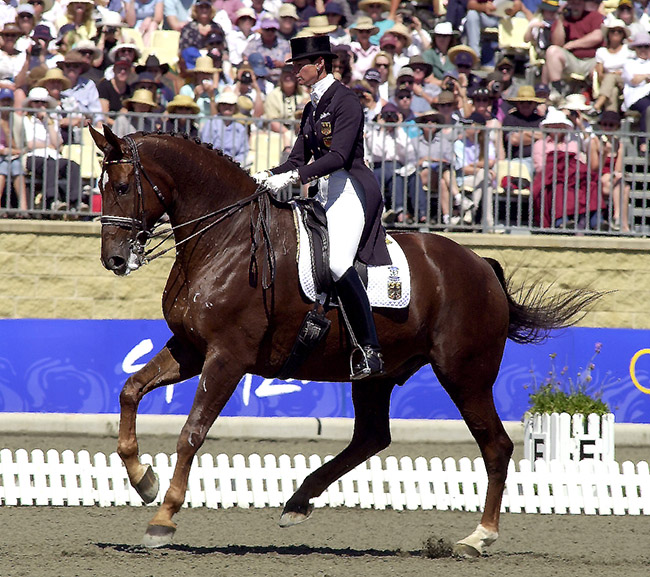
Top dressage stallions are available from International Horse Breeders. For more information go to www.ihb.com.au
Stallions like Vitalis
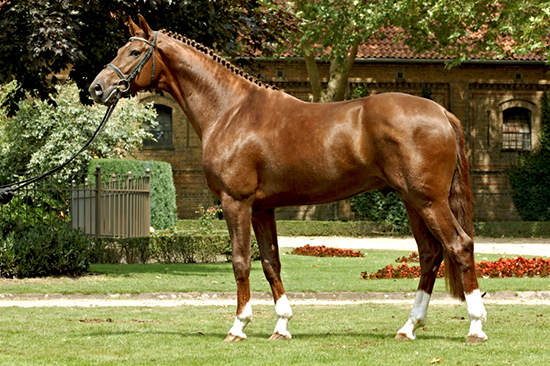
Sir Donnerhall
